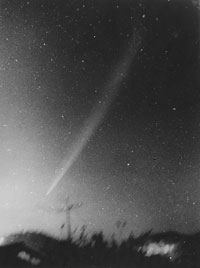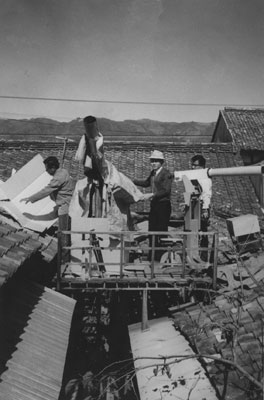
| Return |
| • September 19 There was a public viewing night held at the observatory on September 18 and Mr. Oniwa and I took charge of the event. The lecture room swelled with visitors including 40 students from a primary school in Kochi City and their parents and teachers. The weather wasn't perfect; the stars were visible only intermittently. During cloudy periods, I gave them a talk about the event of exactly 39 years ago today, demonstrating the 9cm comet seeker standing beside me. |
||
 Public viewing night at Geisei Observatory September 18, 2004 |
||
That's right. It was the eve of the discovery of Comet Ikeya-Seki, when Typhoon No. 24 struck this part of Japan. If I had gone to bed thinking the typhoon would strike us, my life could have turned out to be a different one. A seemingly insignificant encounter can change one's life completely. Coincidentally, two people were preparing for observation in Japan at that time under severe weather conditions caused by the typhoon. It can be described as a strange coincidence brought about by fate. |
||
 
|
||
The Masters' National Swimming meet was held today, on September 19, and I entered the 50-meter and 100-meter breaststroke races. Two of the contestants said to me, "This morning's NHK radio was reporting on your discovery." The fact is the October 21st, about one month from now, was the day of Comet Ikeya-Seki's perihelion, much bigger news than the discovery itself. However, it will not make news because it coincides with one important day. On October 21st, 1944, a ceremony was held at Jingu Gaien (Meiji Jingu Shrine Outer Gardens) for the mobilization of students to war. Among the fellow swimmers there was a person who raced with that famous swimmer Furuhashi(*). He told me that he had seen off the departing student-soldiers at the stands of the stadium in a drizzle while listening to General Tojo's speech. Sixty years have passed since. It deeply impressed me that this former renowned swimmer was still actively swimming. The scene of departing soldiers in the news film still haunts me with a deep sorrow. According to him, most of the thousands of student-soldiers who gathered at the ceremony heroically died in battles on Okinawa. When the sky clears up, I will search for comets along the paths of the Kreutz group, though a possibility of finding one will be low. The 9-cm Namura lens I used to discover Comet Ikeya-Seki even now preserves the same luster as in those days. Does my mind still preserve the old luster? This is much more important. (*) Hironoshin Furuhashi The famous Japanese swimmer known as the flying fish from Fujiyama. He set a number of world records in the 400-, 800-, and 1500-meter free-style between 1947 and 1949, while Japan was still in turmoil following the end of the Pacific War. |
||
| • September 14 There were a lot of clouds about in the sky today due to a tropical storm in the southern ocean, but I came to the observatory anyway. This has become the first observation since Typhoon No. 18 (Songda) hit Japan. As soon as I arrived at Geisei, the weather improved and it became a beautiful starry night unusual for summer. During the evening I made photographic observations of C/2001 Q4 (NEAT) and other known comets using the 60cm telescope. Around the midnight I swept the sky opposite the sun. . What I should write specially about today's observing is that the gegenschein (counter glow) was vividly visible, a rather rare occasion. It appeared as a 15-degree-radius round glow between Fomalhaut shining alone in the southern sky and Pegasus in the north. It was half the brightness of the faintest part of the winter Milky Way and I was able to find it effortlessly. I photographed it in monochrome but it would probably be difficult to reproduce it faithfully. After photographing several times with the 60cm telescope, which takes more than 30 minutes per frame, I started to sweep the eastern sky at 4 am and saw several beautiful open clusters. I found comet searching wonderful even if it didn't lead to discovery. The open clusters looked like silvery grains of sand sprinkled over a fuzzy round glow and their beauties would stay in my mind for a long time. The old experience built over a long period of time has now started to be coming back and I am becoming able to recognize comets only by glance. Unlike my early days when I frantically searched for comets, I now hunt for comets for a long-term goal by spending a modest amount of time every month, the same way as Mr. Machholz wrote in his discovery story. At the break of the dawn the intense brightness of Venus and the zodiacal light,, though still faint, were impressive. I turned the 21cm Epsilon telescope beside me to C/2004 R2 (ASAS), which was plunging to the sun, and photographed it by a 3-minute exposure. It captured an 11th-magnitude very diffuse coma. It will be my last tracking of this comet tonight. C/2004 Q2 Comet Machholz, though, showed a firm image with a faint tail in a photograph. It will be presented in Reports from Geisei Observatory. It is brightening gradually day by day and I look forward to its northward passage at the end of the year. |
Copyright (C) 2004 Tsutomu Seki.